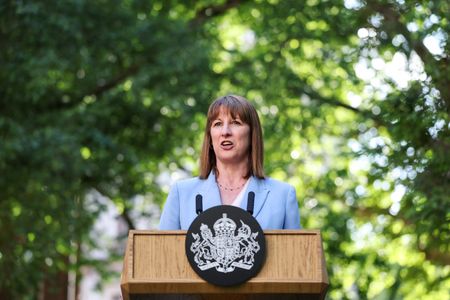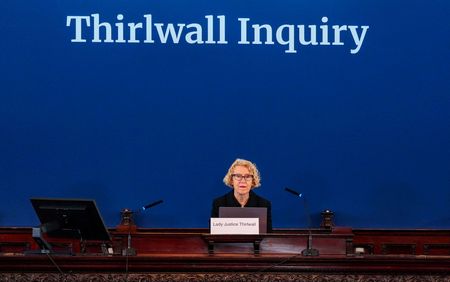By Andy Bruce
MANCHESTER, England (Reuters) -Britain’s government kicked off the 2025/26 financial year in April by again borrowing more than expected, suggesting no let-up in the pressure on the public finances ahead of a major review of spending.
Public sector net borrowing was 20.155 billion pounds ($27 billion) in April, according to official data.
A Reuters poll of economists showed a median forecast of 17.9 billion pounds for public sector net borrowing.
Economists have routinely underestimated the extent of Britain’s budget deficit each month over the past year.
Finance minister Rachel Reeves is due to deliver her first multi-year spending review on June 11 to set the budgets for public services.
She outlined her first annual tax and spending plans last October when she raised social security contributions paid by employers but held off from broader tax increases.
“The decision to hold off on tax rises in the Spring Budget increasingly looks like a temporary reprieve,” said Lindsay James, investor strategist at wealth management firm Quilter.
“As borrowing continues to outstrip forecasts and debt interest costs remain elevated, pressure is building on the Chancellor to make tougher choices.”
With Reeves’ budget plans hinging on a tiny buffer against the government’s self-imposed fiscal rules – equivalent to less than 1% of annual spending – investors are watching public sector finance data closely.
The British government bond market has become increasingly volatile in recent years, reflecting unease among investors over Britain’s mix of slow economic growth, high debt interest costs and persistent inflation.
Thursday’s figures from the Office for National Statistics were the first to estimate the impact of the large hike in employer social security payments, known in Britain as National Insurance contributions (NICs), which came into effect in April.
A major source of funding for the Labour government’s spending plans, the ONS said compulsory social security contributions increased by 12.8% compared with a year ago, on an accrued basis that relies heavily on projections.
Separate HMRC tax data, which records what the government actually received, showed a 7.7% annual increase in employer NICs contributions – the weakest such increase for the month of April since 2020.
But as NICs contributions are paid a month in arrears, it will not be until next month that more concrete evidence of the NICs increase appears in the data.
The ONS revised down its estimate of borrowing for the last financial year that ended in March to 148.3 billion pounds from 151.9 billion pounds previously, or 5.1% of economist output compared to 5.3%. In 2023/24, the deficit was 4.8% of GDP.
In its forecasts published in March, the Office for Budget Responsibility – which provides the fiscal and economic outlooks used by the government – projected a budget deficit for the financial year ending in March of 137.3 billion pounds.
($1 = 0.7447 pounds)
(Reporting by Andy Bruce; Editing by William Schomberg and Hugh Lawson)









